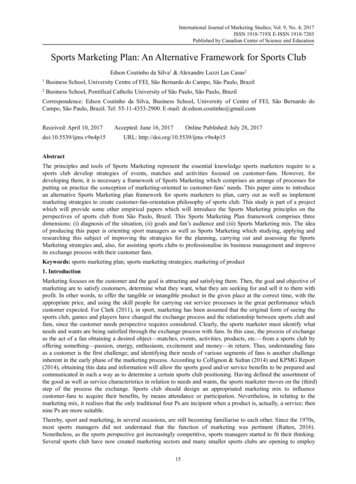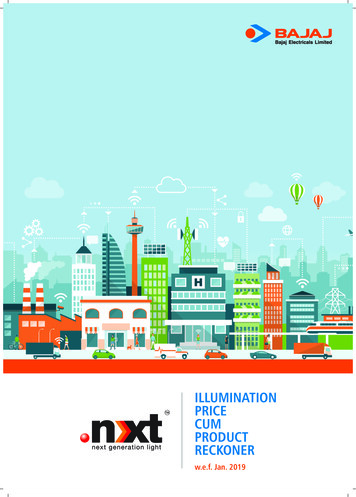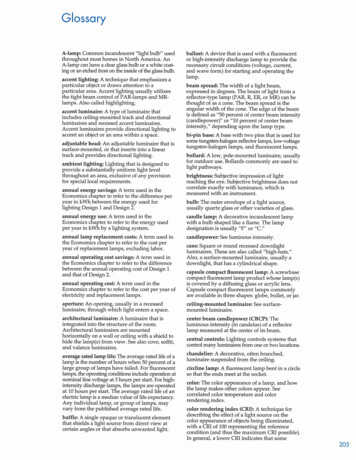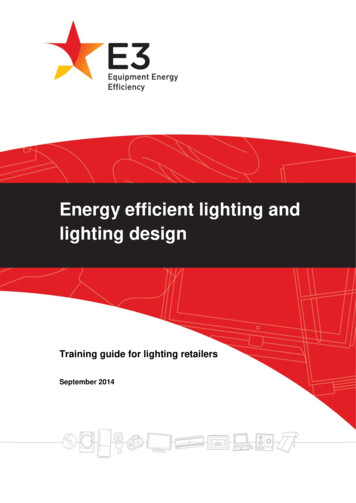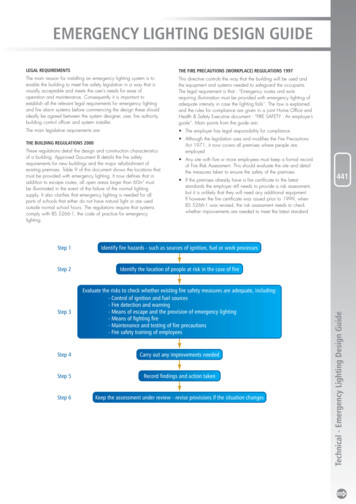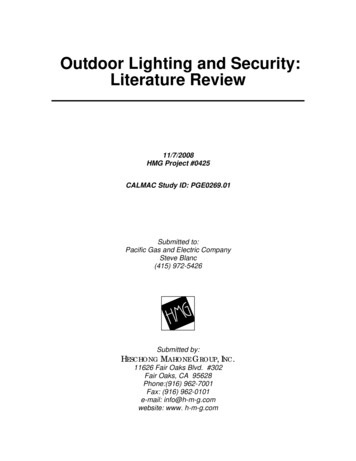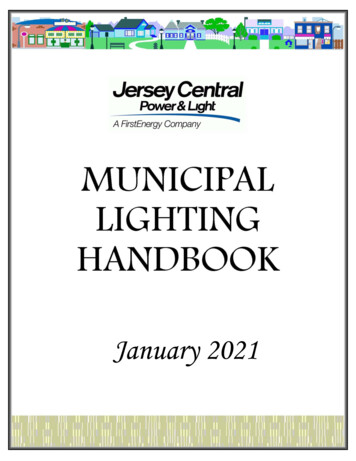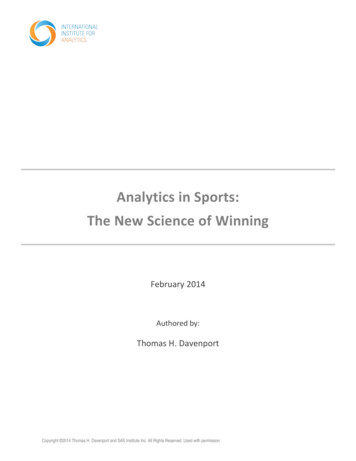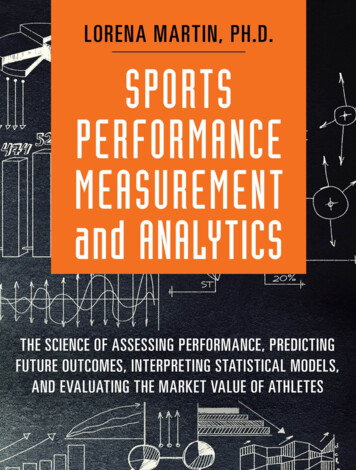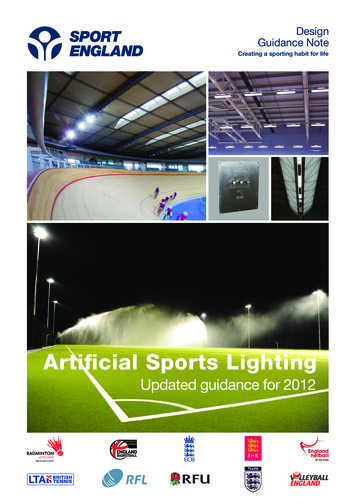
Transcription
DesignGuidance NoteCreating a sporting habit for lifeArtificial Sports LightingUpdated guidance for 2012
Artificial Sports LightingDesignGuidance NoteForewordSport England’s DesignGuidance Notes aim to:Sport England believes that good facilities arefundamental to the development of sportingopportunities for everyone, from the youngestbeginner to the international class athlete. Thebuildings, whether large or small, can encouragecivic pride and assist the process of revitalisingdeprived neighbourhoods. Facilities that are welldesigned, built to last and well maintained are apleasure to use and give an ample return on thetime and money invested in their construction. Increase awarenessof good design insports facilities Help key buildingprofessions, clients,user representativesand otherstakeholders to followbest practiceGood design needs to be based on a soundunderstanding of issues such as current nts in the sport and leisure industry,technical developments in architecture andconstruction and the lessons to be learnt frompreviously built schemes. Encourage welldesigned sportsfacilities that meetthe needs of sportsand are a pleasure touse.Good design needs to be embraced within theearliest vision statement for any project andenshrined in the initial briefing stage through to thefinal detailed specifications and operationalarrangements.Sport England Design Guidance Notes areprovided to help promote a greater understandingand appreciation of overall design concepts, oftechnical issues and of the critical factors thatneed to be considered in reaching appropriatesolutions for a particular project. They also advisewhere further information, advice and expertisemay be found and point to benchmark examples.November Revision 0021 Sport England 2012
Artificial Sports LightingDesignGuidance NoteContents1.0 Introduction4.0 Outdoor Sports Lighting3 FloodlightingooFeasibility Design principlesooSports requirementsooThe overall systemooSite configurationooConsultationooVisual impactooObtrusive lightooLocal site issues Tennis Athletics Multi use games areas (MUGAs) General benefits Technical complexities Professional advice2.0 Design Issues 5General requirementsVolume of the field of playEven illuminationLamp typesLevels of illuminationGlareColours of surfacesLevels of playVisual impairmentGeneral emergency and safety lightingSport specific safety issues3.0 Indoor Sports Lighting245.0 Lighting Cost of Ownership36 GeneralooMaintenance factorooIlluminance measurement and monitoring Energy costsooEnergy tariffs Maintenance costsooGeneralooCleaningooLamp replacementooLuminaire aimingooTypes of maintenance Sinking fund - Life cycle costs Value for money12 GeneralooDeveloping a design strategyooBalancing prioritiesooStandards of illuminance for indoor sportsooOther Sport England Design GuidanceooThe use of daylight Multi-sports hallsooIntroductionooIlluminance requirementsooMulti-sports facilitiesooHorizontal and vertical illuminanceooIlluminance gradient Specialist sports hallsooBadmintonooIndoor bowlsooIndoor cricketooFitness centresooIndoor tennis Swimming poolsooIntroductionooDesign aspectsooLight fittingsooUnderwater lightingooMaterials and corrosionAppendix 141Simplified definitionsAppendix 243Light emitting diode (LED) lightingAppendix 344Indoor Sports - Summary of therecommendations of BS EN 12193 withadditional notes on key design issuesAppendix 451Outdoor Sports - Summary of therecommendations of BS EN 12193 withadditional notes on key design issuesAppendix 556Lighting codes, standards and guidesAppendix 658Design check listNovember Revision 0022 Sport England 2012
Artificial Sports LightingDesignGuidance Note1.0 IntroductionGeneral benefitsThe creation of an appropriate visual environmentis a fundamental requirement in sports design andthe effective integration of the artificial lightingsystem should be considered as a standard part ofa modern sports facility.The general benefits of good artificial lighting canbe readily understood:This Design Guidance Note considers artificialsports lighting for both internal and external sportsactivities and identifies those that have specialrequirements. Its aims are: To give a basic explanation of a complexsubject Updating basic industry guidance on the typesand levels of lighting needed for differentsports – See Appendices 3 and 4 To cross-reference to other sources ofinformation. Indoors, artificial lighting helps designers toprovide consistent, uniform, adequate lightinglevels, sometimes using artificial lighting aloneand sometimes with supplementation bydaylight In facilities such as swimming pools, artificiallighting is essential for the maintenance of safeconditions Outdoors, providing artificial lighting on asports facility greatly extends the hours ofplay, particularly in winter The high, uniform levels of light necessary formany televised sports events can only beensured through artificial lighting.The principles of lighting design are illustrated bya few descriptive outlines referring to specificsports and activities. Similar methods andprinciples can be used in the procurement oflighting for any sport or mixture of sports.November Revision 0023 Sport England 2012
Artificial Sports LightingDesignGuidance NoteTechnical complexitiesProfessional adviceLighting is a subject area with a high degree oftechnical complexity that can be difficult tounderstand.This Design Guidance Note is not intended to bea substitute for appointing the appropriateprofessionally qualified organisations, who will berequired to develop the:The complicating factors which need to be takeninto account in developing a lighting design mayinclude: Sports lighting performance requirements intoacceptable design solutions and specifications The varying and conflicting requirements ofindividual sports in a multi-sports context A lack of appreciation of the needs of someindividual sports that are particularly sensitiveto poorly designed lightingOther environmental lighting that will berequired for support areas in and around thebuilding or outdoor pitch Related systems such as electrical supply,wiring and controls. Complex inter-relationships with other elementsof the building such as:OOReflectance and colour of surfacesOOVariation in background surfacesOOConfiguration of walls and roofOOLocation of structural supportsFor information on theselection of specialistlighting consultants andcontractors, consult:Wider inter-relationships with issues such as:OOUser satisfactionOOOverall sustainabilityOOEnergy usageOOEnvironmental factorsOOAvailability of a suitable electrical supply The Society of Light andLighting (CIBSE) Sports and PlayConstructors Association(SAPCA) Sport England’s frameworkHealth and safety issues, for example inswimming pools or in fast moving ball gamessuch as cricket or hockey, where themaintenance of a good lighting system is afundamental requirement.November Revision 002list of lighting contractors.4 Sport England 2012
Artificial Sports LightingDesignGuidance Note2.0 Design IssuesGeneral requirementsHIt is important that the lighting requirements of eachsport are fully understood at the outset of a project.This requires an understanding of the nature of thesporting activity and key characteristics. Manysports involve swift player actions and reactionsand involve relatively small objects such asshuttlecocks and balls travelling within threedimensions at very high speed.LDesign ConsiderationsVolume W x L x HLighting installations forsport should balance thefollowing issues within anintegrated design:WConsider the full volume of the sports space to be illuminatedFor example, a lighting scheme for badmintonshould not be based solely on illuminance on thefloor, when the path of the shuttlecock can beanywhere in a playing volume 7 - 9 m high. Levels of illuminance Uniformity of illuminance ContrastAs well as the area bounded by the pitch or courtperimeter line (the ‘Principal Area’), additionalsafety or run off zones (making up the ‘Total Area’)will need to be lit. Consideration must be given tothe lighting levels both on the surfaces of and inthe volume above each of these zones. Glare control Colour rendering Compliance with statutoryregulations.Volume of the field of playThe whole of the three-dimensional volume aboveand including the field of play should beconsidered, rather than just the two-dimensionalsurface of the playing area.Fig.1 Visibility issues need to be considered throughoutthe volume of the field of playThis can include: Safety zones around the playing area Space reserved for officials and team benches The underwater volume in the case of aswimming pool Spectator facilities.Where events are televised, or for sports whichinvolve great use of the height above the playingarea - for instance badminton, athletics throwingevents, cricket, rugby - consideration of the fullvolume is especially important. In lightingengineering terms, this means considering bothhorizontal and vertical planes for the full volume ofthe field of play.November Revision 0025 Sport England 2012
Artificial Sports LightingDesignGuidance NoteLamp typesThere is a variety of different lamp types used forsports lighting, as shown in the table below. Theircharacteristics differ and manufacturers arecontinually developing improved products. Selectionis often made on the basis of colour of light emitted,energy consumption and life expectancy.For up-to-date informationon sports dimensions, seethe Sport England ‘SportsData Sheets’ and theSport England GuidanceNote ‘Comparative Sizesof Sports Pitches andCourts’.Types of lampsIndoorsTubular fluorescentCompact fluorescentMetal halideEven illuminationHigh pressure sodiumGenerally, the full volume of the field of play shouldbe illuminated evenly to create equal playingconditions for all players and to create a consistentlevel of visibility. Changes in illuminance levels cancreate difficulties in judging the speed and thetrajectory of the playing object.Light emitting diode (LED)OutdoorMetal halideHigh pressure sodiumTungsten halogenSports areas should be lit so that those taking partand those watching can see clearly all that is goingon. This calls for suitable brightness and contrastover the playing area, sufficient light at all points,correct distribution of light and adequate controlof glare. Playing objects will be seen because theycontrast with their background in brightness,colour or both. The more marked the contrast, themore clearly objects are perceived in general. Forinstance, for Badminton a reduction in illuminationbehind the court is preferred to achieve anacceptable background contrast. (See section onBadminton, page 16.)For both indoor and outdoor sports, sodiumlighting will only be acceptable where itsrelatively poor colour rendering can be tolerated.Tungsten halogen lights are inexpensive, butinefficient. Metal halide lamps are efficient andgive good colour rendering. They are specificallyrecommended by some National GoverningBodies for Sport (NGBs). For indoor use,fluorescent lamps offer a good balance betweencost and efficiency.Light emitting diode (LED) lights are starting tobe offered for sports lighting purposes. Adecision as to whether or not to use LED lights iscomplex, because there are many variables toconsider and because LED technology isadvancing rapidly.For further information on LED lighting for indoorand outdoor sports, see Appendix 2.Contrast in illumination levels and shadows should beavoided in the field of playNovember Revision 0026 Sport England 2012
Artificial Sports LightingDesignGuidance NoteContrasts in illuminance inthe volume of the field ofplay should be avoidedReflected light from ceilingcan improve spread oflight in the volumeXEven illumination is required in the full volume of the field of playLevels of illuminationOOThe level of illumination that is appropriate for aparticular sport should be checked with therequirements of the National Governing Body(NGB) or the organisation that is promoting aparticular event. This can vary with the level of playand competition. Verification that minimumstandards are being achieved can be a requirementfor each individual event, as in the case of hockey. to use low-intensity light sources, such asfluorescent tubes.The locations of the luminaires.Reflected light from ceilingWherepossible,luminaires should be locatedcan improvespread ofinlightpositionswhich mean that players will notin the volumeneed to look towards them or in their generaldirection in the course of a game, for examplebehind the badminton baseline.The CIBSE Lighting Guide 4 2006 and BS EN12193:2007 give general recommendations for therange of lighting standards. However, it should benoted that in some cases, these differ from therequirements of the NGBs requirements as notedin Appendices 3 and 4.GlareThe complete elimination of glare in sport isdifficult to achieve due to the ever-changingdirections of view of participants. Nevertheless,measures should be taken to minimise glare thatmay affect the visual performance of participants.When attempting to minimise the likelihood ofglare, the factors over which a designer has controlare; Selection of luminaires designed with attentionto the avoidance of glare.In designing a luminaire, there are two mainmethods of avoiding causing glare, which are;OOto make any direct view of the light sourceimpossible by placing it deep within theluminaire, behind bafflesNovember Revision 002Inappropriately located lights can cause discomfort glare7 Sport England 2012
Artificial Sports LightingDesignGuidance NoteIndoors, generally down-lighter type luminairesshould be used that incorporate some glare controlwith some degree of back lighting to avoid highlevels of contrast.Artificial lighting integratedinto roof structure andlocated to avoid glareOutdoors, the use of high-intensity dischargelamps because of their high light output andefficiency means that any view of a light source willcause glare. Use of baffles might prevent directsight of the light source, but is avoided by mostmanufacturers because it reduces the efficiency ofthe luminaire.The locations of luminaires relative to directions ofview should be considered carefully. Some NGBshave very specific requirements relating to thepositioning of luminaires in relationship to the courtmarkings and field of play. Examples are badminton,where fittings must not be over the actual courts,and basketball and netball, where there areminimum distances from the goals. Both theInternational Hockey Federation (FIH) and FIFAstipulate a minimum angle of 25o above thehorizontal from the pitch centreline to the lowestluminaire and FIFA guidance states that thecolumns should not be within 10o of the goal line,measured from the centre of the goal. Alwaysconsult the NGB rules and BS EN 12193:2007.Even lighting towhole volumeof playPlay object wellilluminated and withgood contrast withbackground coloursNatural and artificial lighting sources integrated withbuilding structureLight positioned /screened to avoidglareIn sporting environments, similarly to indoorworking conditions, glare should be calculatedusing the unified glare rating (UGR) method andlimiting values used shall be those specified inprEN 12464.Colours of surfacesThe colours of the surfaces in a sports hall - walls,ceiling, dividing nets - are often important becausethe play object will be seen against them.Choosing the right colours can help make the playobject more visible. For example, a mid-rangereflective surface helps badminton players see awhite shuttlecock and a surface of higherreflectance helps players see the flight of a redcricket ball.1 Glare critical if in linewith the play objectThe brightness of a surface depends on its colourand its reflectance or LRV.Lighting should not be located in direct line of sight ofthe playerNovember Revision 0028 Sport England 2012
Artificial Sports LightingLevels of playDesignGuidance Notedifferent again, of classifying the levels of play intheir particular areas of expertise. Lighting levelsshould be compared with the requirements ofindividual NGBs and / or the promoter of a particularevent.The general levels of play for sports activity aredefined in the CIBSE Lighting Guide 4 and similardefinitions are used in the more recent BS EN12193:2007. However, they can be very difficult tointerpret in that they use general, overlappingterms that might not correspond exactly with thetypes of use that are to be accommodated.The table below provides guidance on the newlevel of play categories for each sport as agreedby the NGBs and Sport England.Sport England use a more descriptive approachalthough some NGBs have their own methods,VolleyballCricketInternationalN/ASenior EBLMen Division 1This category relatesand 2, Womento a Premier /Division 1National LeagueClub competing inregional or Intercounty competitionsNationalRegional andInter-CountyPremier League Championships League ClubN/AClubSenior EBLMen Division 3This category relatesand 4, Womento a local clubDivision 2competing in Districtand County League EBL YouthLeaguescompetitions.Local club andinter countycompetitionPremier Club ina CommunityBadmintonNetworkClubClubCommunitySchool andrecreationaluseRecreationalClubPractice andschool rnationalInternational and InternationalSuper LeagueHighPerformanceCentresThis category relatesto the lowest level ofInternational play 1.PremierRecreationalThis category relatesto school andcommunity usewhere there is noformal competitivestructure / nospecific need forspace for officials TournamentCircuitsPremier Club ina PerformanceCentre1 For higher levels of international competition, such asmajor championships, the relevant NGB should be consultedat a very early stage as the requirements vary considerably.November Revision 0029 Sport England 2012
Artificial Sports LightingDesignGuidance NoteVisual impairmentThe term ‘visual impairment’ refers to a permanentloss or reduction of the visual function.See separate Sport EnglandDesign Guidance Note‘Accessible Sports Facilities’for advice on creating a‘confusion free’ visualenvironment within sportsbuildings that includes:The illuminance values typically quoted in lightingreferences are those relevant to individuals offorty years of age. These take no account of theeffects of the ageing eye, the changes in whichcan be sub-divided into physical and perceptualchanges. Careful location and controlof natural and artificiallighting Accentuation of contrastand texture to help peoplewith visual impairments Gradual changes in lightinglevels from area to areaThe most common age-related changes in visionand their effects on everyday activities can includethe following: Avoidance of shadowing atkey areas such asreception desks Decreased ability to focus close up Increased lighting requirements Increased sensitivity to glareand reflecting surfaces Reduced contrast sensitivity Avoidance of spot lights Decreased colour sensitivity Increased time required to adjust to bright lightand / or darkness Decreased ability to judge depth. Control of glare and shinnyand up lighters set in thefloor.General emergency and safety lightingSuch changes can, either individually or incombination, typically give rise to a requirementfor increased illuminance levels when older peopleare carrying out similar visual tasks (refer to CIBSELG4 for further information). Estimates vary buttypically, a 60 year old needs twice as much lightto do the same task as a 20 year old.Emergency lighting, which is covered by BS 5266,is required in the event that the main lightingsystem might fail. Part 7 of BS 5266 includes thetotal requirements of the European EmergencyLighting Standard – EN 1838.The classification of buildings and the areas withinthat require emergency lighting are defined in theBuilding Regulations Approved Document B – FireSafety. See CIBSE Technical Memorandum 12:Emergency Lighting which includes the designaspects of conventional emergency lighting.Increased lighting levels may remedy some of theproblems experienced by older individuals but thiscan also sometimes cause further problems byincreasing the risk to others who may be moreeasily affected by sources of glare.There are two major subdivisions of emergencylighting i.e. ‘escape lighting’ and ‘standby lighting’.Escape lighting is provided for safety reasons toensure safe and effective evacuation of a buildingin an emergency, while standby lighting may beprovided to enable normal activities to continuedespite an emergency.The ability to control the light output from aninstallation using selective switching may providesome improvement in playing conditions but it hasto be appreciated that this will only be of benefitto those players who suffer from the same orsimilar types of visual impairment.November Revision 00210 Sport England 2012
Artificial Sports LightingDesignGuidance NoteSport specific safety issuesSee also the following publications:For sports applications, standby lighting can befurther subdivided into ‘safety lighting’ and‘continuation of an event’. The degree of standbylighting provided will be influenced by the natureof the activities being undertaken, the duration ofthe activities and the level of associated risksinvolved. The Good Practice Safety Guide for small andsporting events taking place on the highway,roads and public places: Home Officeh t t p : / / w w w. r u n b r i t a i n . c o m / s t a t i c / p d f s / rd p /event-safety-guide.pdf BS EN 12193:2007 provides guidance on ‘safetylighting’, the purpose of which is to ensure that inthe event of a power failure a sporting activity canbe safely stopped without causing injury toparticipants.Guide to Safety at Sports Grounds - fifthedition: Department For Culture, Media andSport publication available from The SportsGrounds Safety Authority web /greengde.phpProvision of standby lighting with the purpose ofallowing events to continue to their conclusion inthe event of failure of the main lighting system isnot usually economical. Exceptions will beprovision of alternative cover for major events,where loss of lighting would cause unacceptablecancellation.The lighting level for the safe stopping of an event is apercentage of the level for that class. This applies tothe following sports and percentages listed below:Sport% for minimumperiod (seconds)Swimming5% for 30sIndoor gymnastics5% for 30sIndoor and outdoor equestrian5% for 120sSpeed skating5% for 30sBobsleigh and toboggans10% for 120sSki jump and landing10% for 30sSki slopes10% for 30sCycle racing10% for 60sThe safety lighting shall come on the instant the generallighting fails and last for at least the period specified.BS EN 12193:2007 safety lighting levels and minimumperiodsNovember Revision 00211 Sport England 2012
Artificial Sports LightingDesignGuidance Note3.0 Indoor Sports LightingBalancing prioritiesGeneralA good sports lighting system should provideadequate illuminance, suitable brightness, contrast,uniformity of light distribution and satisfactorycontrol of glare for the activities in question.It is generally recommended that the lightingdesign is based on the requirements of thepriority activities i.e. the sports that are playedmost often or have the most stringentrequirements. However, all other potentialactivities should be catered for in terms of basicvisual safety and functionality.The lighting schemes will have a major influenceon the overall ambience of the playing space.For example, in many multi-sports halls inEngland, a lighting design that caters well forbadminton with courts running across the hall willgive adequate conditions for the sports that areplayed along the length of the hall.Many indoor sports facilities cater for a range ofactivities. Some of these different activities cantake place simultaneously, for example in a sportshall divided into sections. There may also be aneed to achieve adequate visual conditions forspectators. Non-sporting use such as schoolexaminations and community events may alsoneed to be accommodated.However, a common enhancement is to provideadditional switchable lighting systems for sportssuch as cricket or other sports played down thelength of the hall that have specific competitionrequirements. In some cases, or where there arepriority activities with widely different orconflicting requirements, this can mean theprovision of separate lighting systems - see SportEngland’s ‘Affordable Sports Halls’ Appendix 9.Where substantial variations in illuminance arerequired, additional switching of supplementarylighting could be considered.Developing a design strategyThe table below summarises the key steps indeveloping a lighting design strategy.Standards of illuminance for indoor sportsBS EN 12193:2007 provides guidance on thelevels of illuminance for different sports, indoorand outdoor. However, this guidance conflicts insome cases with NGB requirements. Levels ofilluminance vary with levels of play. Internationalor Premier level of play will require higher lightinglevels than Club or Community level of play.Design StrategyConfirm the layout(s) ofsports areasAnalyse and prioritise interms of programme andbuilding operationDefine the volume(s) ofthe field(s) of playSee Appendices 3 and 4 for a summary table withhighlights of key design considerations.Identify adjacent areaswith visual linksEstablish the generallighting requirementsSee BS EN 12193:2007for general illuminationEstablish the NGBsdetailed requirementsand the pattern of lightsto be switched aroundindividual courts (in amulti sports situation)See Sport England / NGBrequirements andestablish / resolve anyconflicts with industryreferencesBS EN 12193:2007 also gives the dimensions forthe ‘principal area’ and ‘total area’ of the field ofplay. Together with the required heights, theseareas define the volume in which illumination isrequired and which the lighting design mustaddress.Any other adjacent volumes such as those of anycirculation, spectator and storage areas that arevisually linked with the field of play should alsobe considered.Sports lighting should be:In the case of a multi-sports facility, therequirement of each individual sport must beidentified and prioritised. Considered early in thebuilding design process Well integrated into thedesign of the facility Not treated as a separatespecialist fit-out issue.November Revision 00212 Sport England 2012
Artificial Sports LightingOther Sport England Design Guidanceeven dangerous. Any proposal to use natural lightrequires very careful consideration of how glarecan be controlled and how reasonably stable anduniform levels of lighting can be ensured.There are several Sport England Design GuidanceNotes in which relevant information is provided: Accessible Sports Facilities Affordable Sports Halls Badminton Comparative Sizes Check List Design for Sport on School Sites Fitness and Exercise Indoor Bowls Sports Data Sheets Sports Halls Design and Layouts Swimming Pools Swimming Pools Audit Check List Village and Community Halls.DesignGuidance NoteConsider the health andsafety risk of a flash ofsunlight causing badmintonplayers to lose sight of ashuttlecock flying towardsthem at 200 mph.Some of the issues can be ameliorated within thedesign of the rooflights themselves but generallythis will incur additional capital costs. Theseshould be carefully considered against thepossible energy savings and other benefits thatmight be accrued across the life of the building.For example, rooflights can be designed withscreening layers to diffuse the incoming daylightand help distribute light evenly over the field ofplay. Automatic black out blinds can also beincorporated to eliminate the risk of glare at timeswhen critical sports such as Badminton areplayed. The light output of the artificial lightingsystem can also be controlled through anautomatic dimming system to achieve aconsistent level of lighting.The use of daylightThe use of natural light in indoor sports spacesto augment the artificial lighting system thatwould normally be required is an issue that oftengenerates conflicting interests.For some NGBs, natural lighting of indoor spacesis completely unacceptable. The sun or areas ofbright sky seen either directly through windowsor by reflection from bright surfaces within thesports hall can lead to a level of disability ordiscomfort glare that will be unacceptable orSome of the advantages and disadvantages ofusing natural daylight to illuminate all or part of asports hall are covered in the table below.AdvantagesDisadvantagesMaintains a link with the outside world.Can contribute to an unacceptably high levels ofdirect and / or reflected glare that can be a healthand safety risk for sports such as Badminton.Engenders a feeling of well-being among theoccupants of the space.Sudden fluctuations in the intensity of sunlightpenetrating into a sports hall through windows canlead to problems in maintaining uniformity ofilluminance over the field of play. This can lead toreduction in the ability of participants to accuratelyjudge velocity of sports balls etc.Can contribute energy savings by reducing thehours that the artificial lighting is switched on.Requires north facing fenestration in order tominimise the effects of direct sunlight.Can increase energy costs through increase levelsof heat loss.Advantages and disadvantages of using daylight for illuminating sports hallsNovember Revision 00213 Sport England 2012
Artificial Sports LightingMulti-sports hallshowever, the extent to which this can be achieveddepends largely upon the qualities of the playingsurface, including its spectral reflectance and anysurface texture, as well as the manner in which
Light emitting diode (LED) lights are starting to be offered for sports lighting purposes. A decision as to whether or not to use LED lights is complex, because there are many variables to consider and because LED technology is advancing rapidly. For further information on LED lightin
